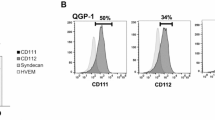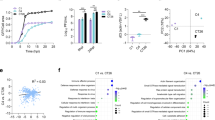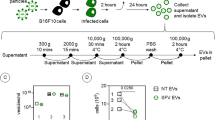Abstract
The potential use of oncolytic viruses in the treatment of cancer has been investigated for some time. A variety of agents have been studied, including some which appear to be selectively replication-competent in cancer cell lines. In this study, we have investigated the ability of herpesvirus saimiri to specifically lyse selected human cancer cell lines. Upon infection with a replication-competent virus carrying the EGFP reporter gene and a neomycin resistance marker, the pancreatic cancer lines MIAPACA and PANC-1 exhibited definite cytopathic effects. In contrast, the colonic carcinoma cell lines SW480 and HCT116 were phenotypically unaltered. In addition, stable cell lines could not be generated from PANC-1 infected cultures, in marked contrast to cultures of cells from other human tissues. Virus recovery assays demonstrated that all of the cell lines produced a small amount of virus post-infection, but that virus replication was minimal after 1 week in culture. In addition, treatment with acyclovir inhibited virus replication but paradoxically increased cytopathic effect. These data suggest that herpesvirus saimiri may have potential as an oncolytic agent for the treatment of pancreatic cancer. © 2000 Cancer Research Campaign
Similar content being viewed by others
Article PDF
Change history
16 November 2011
This paper was modified 12 months after initial publication to switch to Creative Commons licence terms, as noted at publication
References
Arai H, Gordon D, Nabel EG and Nabel GJ (1997) Gene transfer of the Fas ligand induces tumour regression in vivo. Proc Natl Acad Sci USA 94: 13862–13867.
Biesinger B, Muller-Fleckenstein I, Simmer B, Lang G, Wittmann S, Platzer E, Desrosiers RC and Fleckenstein B (1992) Stable growth transformation of human T lymphocytes by herpesvirus saimiri. Proc Natl Acad Sci USA 89: 3116–3119.
Bischoff JR, Kirn DH, Williams A, Horn S, Muna M, Ng L, Nye JA, Sampson-Johannes A, Fattaey A and McCorrmick F (1996) An adenovirus mutant that replicates selectively in p53-deficient human tumour cells. Science 274: 373–376.
Clayman GL, el-Nagger AK, Roth JA, Goepfert H, Taylor DL and Liu TJ (1995) In vivo molecular therapy with p53 adenovirus for microscopic residual head and neck squamous carcinoma. Cancer Res 55: 1–6.
Culver KW, Ram Z, Walbridge S, Ishii H, Oldfield EH and Blaese RM (1992) In vivo gene transfer with retroviral vector-producer cells for the treatment of experimental brain tumours. Science 256: 1550–1552.
Desrosiers RC, Burghoff R, Bakker A and Kamine J (1984) Construction of replication-competent herpesvirus saimiri deletion mutants. J Virol 49: 343–348.
Desrosiers RC, Bakker A, Kamine J, Falk L, Hunt R and King N (1985) A region of the herpesvirus saimiri genome required for oncogenicity. Science 228: 184–187.
Desrosiers RC, Silva D, Waldron L and Letvin N (1986) Non-oncogenic deletion mutants of herpesvirus saimiri are defective for in vitro immortalization. J Virol 57: 701–705.
Elion GB (1980) The chemotherapeutic exploitation of virus-specified enzymes. Adv Enzyme Regul 18: 53–66.
Fleckenstein B and Desrosiers RC (1982) Herpesvirus saimiri and herpesvirus ateles. The Herpesviruses 1: Roizman B (ed) pp 253–332, Plenum Press: New York
Grassmann R and Fleckenstein B (1989) Selectable recombinant herpesvirus saimiri is capable of persisting in a human T-cell line. J Virol 63: 1818–1821.
Heise CC, Sampson JA, Williams A, McCormick F, Von HD and Kirn DH (1997) ONYX-015, an E1B gene-attenuated adenovirus, causes tumour-specific cytolysis and antitumoural efficacy that can be augmented by standard chemotherapeutic agents. Nat Med 3: 639–645.
Heise CC, Williams A, Olesch J and Kirn DH (1999) Efficacy of a replication-competent adenovirus (ONYX-015) following intratumoral injection: intratumoral spread and distribution effects. Cancer Gene Ther 6: 499–504.
Johnson PA, Wang MJ and Friedmann T (1994) Improved cell survival by the reduction of immediate-early gene expression in replication-defective mutants of herpes simplex virus type 1 but not by mutation of the virion host shutoff function. J Virol 68: 6347–6362.
Koomey J, Mulder C, Burghoff R, Fleckenstein B and Desrosiers RC (1984) Deletion of DNA sequences in a non-oncogenic variant of herpesvirus saimiri. J Virol 50: 662–665.
Medveczky P, Szomolanyi E, Desrosiers RC and Mulder C (1984) Classification of herpesvirus saimiri into 3 groups based on extreme variations in a DNA region required for oncogenicity. J Virol 52: 938–944.
Medveczky MM, Szomolanyi E, Hesselton R, DeGrand D, Geck P and Medveczky PG (1989) Herpesvirus saimiri strains from three DNA subgroups have different oncogenic potentials in New Zealand white rabbits. J Virol 63: 3601–3611.
Nigro JM, Baker SJ, Preisinger AC, Jessup JM, Hostetter R, Cleary K, Bigner SH, Davidson N, Baylin S, Devilee P, Clover T, Collins FS, Weston A, Modali R, Harris CC and Vogelstein B (1989) Mutations in the p53 gene occur in diverse human tumour types. Nature 342: 705–708.
Rampling R, Cruickshank G, Maclean A and Brown M (1998) Therapeutic replication-competent herpes virus. Nat Med 4: 133
Redston MS, Caldas C, Seymour AB, Hruban RH, da Costa L, Yeo CJ and Kern SE (1994) p53 mutations in pancreatic carcinoma and evidence of common involvement of homocopolymer tracts in DNA microdeletions. Cancer Res 54: 3025–3033.
Roth J and Cristiano RJ (1997) Gene therapy for cancer: what have we done and where are we going?. J Natl Cancer Inst 89: 21–39.
Sandig V, Brand K, Herwig S, Lukas J, Bartek J and Strauss M (1997) Adenovirally transferred p16INK4/CDKN2 and p53 genes cooperate to induce apoptotic tumour cell death. Nat Med 3: 313–319.
Simmer B, Alt M, Buckreus I, Berthold S, Fleckenstein B, Platzer E and Grassmann R (1991) Persistence of selectable herpesvirus saimiri in various human haemopoietic and epithelial cell lines. J Gen Virol 72: 1953–1958.
Stevenson AJ, Cooper M, Griffiths JC, Gibson PC, Whitehouse A, Jones EF, Markham AF, Kinsey SE and Meredith DM (1999) Assessment of herpesvirus saimiri as a potential human gene therapy vector. J Med Virol 57: 269–277.
Whitehouse A and Stevenson AJ (1999) Gene regulation in Herpesvirus saimiri and its implication for the development of a novel gene therapy vector. Gene Therapy and Molecular Biology 3: 35–44.
Author information
Authors and Affiliations
Rights and permissions
From twelve months after its original publication, this work is licensed under the Creative Commons Attribution-NonCommercial-Share Alike 3.0 Unported License. To view a copy of this license, visit http://creativecommons.org/licenses/by-nc-sa/3.0/
About this article
Cite this article
Stevenson, A., Giles, M., Hall, K. et al. Specific oncolytic activity of herpesvirus saimiri in pancreatic cancer cells. Br J Cancer 83, 329–332 (2000). https://doi.org/10.1054/bjoc.2000.1346
Received:
Revised:
Accepted:
Published:
Issue date:
DOI: https://doi.org/10.1054/bjoc.2000.1346



